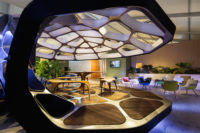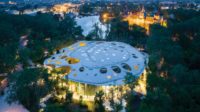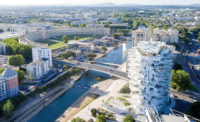Like young architects everywhere, Japanese designers often get their first job from a family member or friend. Rarely, though, does the assignment involve a mental hospital in the middle of a remote, northern island buffeted by Siberian winds. But Sou Fujimoto's psychiatrist father runs a residential facility on Hokkaido. And when the hospital needed an additional building, the doctor turned to his 20-something son, even though the ink on his undergraduate diploma from Tokyo University was barely dry. Earmarked for occupational therapy, the 1,938-square-foot building was realized with the aid of a local architect.
After this debut, Fujimoto hit a five-year dry spell. But instead of closing up shop, going to graduate school, or joining an established firm, he bided his time with competitions and conceptual explorations. "My goal was to create a completely different way to design architecture," he explains. Forsaking standard columns, slabs, and stairs, he envisioned a single, multipurpose element that could play all three roles. This idea coalesced in Primitive Future House, a theoretical project made entirely of stacked slabs that can serve as structure, stairs, fenestration, even furniture.
Now Fujimoto is getting the chance to test this radical approach by designing Atelier/House in Hokkaido for his artist brother. Instead of conventional floors, it consists of five, vertically stacked layers of space used in various combinations to delineate human-scaled, functional areas. Though staggered in section, the project is essentially one room that contains places of different heights and character, explains Fujimoto. Straddling the line between nature and artifice, Atelier/House was not tailored exclusively to the client's needs. Instead, Fujimoto expects his brother to make accommodations to the house. It is precisely this paradox of integrating accidental places and architecture that motivates Fujimoto.
Such unintentional spaces have already generated positive responses from a discerning group of users'the kids who reside at a 50-bed treatment center for mentally disturbed children in Hokkaido's Date City. Commissioned by one of his father's colleagues, Fujimoto created a building that looks like a haphazard group of boxes bound together with window walls. Inside, it works as a pint-size city composed of free-form plazas and tiny cubic buildings. Though the quirky corners and awkward alcoves between minibuildings might make adults blanch, the kids adore them. "Children always invent new uses for space," explains the architect.
Instead of complying with an overriding order, most of Fujimoto's works are compilations of local relationships between one functional zone and its neighbors. Sculptural and site-specific, each rendition of this idea, be it a house or a hospital, is more concerned with the connection between individual parts than the building form or plan as a whole. At the moment, he is taking this concept to new heights in his design for Tokyo Apartment, a five-unit housing project composed of 13 pitched-roof house forms stacked helter-skelter. Though it looks precarious, this building echoes the organic, urban character of Tokyo, the city that Fujimoto now calls home. "I think the city is both very artificial and very natural," says Fujimoto. "For me, this is a very fresh experience."











Post a comment to this article
Report Abusive Comment